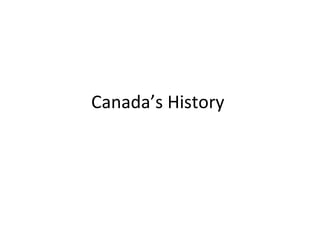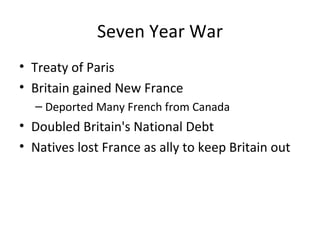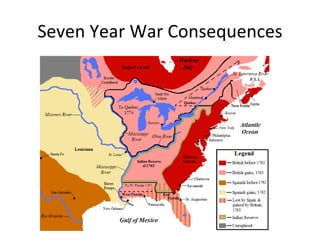CanadaŌĆÖs History
- 3. Fur Trade Charter from King Charles II Included the region watered by all rivers and streams feeding the Hudson Bay Provided money to Britain through the Fur Trade Made Canada valuable
- 4. French Influence French tried to settle Canada for Fur Trade Battles with the Native Americans and British prevented them from settling firmly. King Louie XIV took control of New France Created Civil Law (still evident today) Yellow = New France Green = Disputed Area Tan = FranceŌĆśs Acknowledgment of British land
- 5. Seven Year War Treaty of Paris Britain gained New France Deported Many French from Canada Doubled Britain's National Debt Natives lost France as ally to keep Britain out
- 6. Seven Year War Consequences
- 7. War of 1812 British and U.S. fight for possessions of British Colonies in Canada British are victorious United British-Canadians and French-Candadians What would have happened in the U.S. had defeated Britain?
- 8. Act of Union 1840 United Upper and Lower Canada Unfair to the French population Established a single Parliament Still part of the British Empire but Canada ruled themselves
- 9. Statute of Westminster 1931 Formaly declared Canada was no longer under British authority Meant Canada, Australia, New Zealand, South Africa, and Newfoundland where no longer British colonies CanadaŌĆÖs Federal government was now in charge
- 10. Quiet Revolution
- 11. Commonwealth
- 12. Road to Independence Important dates in the road to independence were the withdrawal of the British troops from Canada (1871), the negotiation of the Washington Treaty (1871) where for the first time a Canadian was included in a British negotiating team to sign a treaty on behalf of Canada, the establishment of the Supreme Court of Canada (1875), the creation of a High Commissioner's Office in London to "represent" Canada (1878), MacdonaldŌĆÖs refusal to send Canadian troops to the Sudan (1885), the last use of the veto (1873) and reserve powers by Britain (1886) under ss. 55-57 of the Constitution Act, 1867, and the establishment of the Department of External Affairs (1909). It was the First World War that accelerated the process to independence. The major colonies played a role of such magnitude that it could not be said, by the end of the war, that they were mere colonies of Great Britain. Hence, the international status of Canada evolved rapidly in the post-World War period: in 1919, Canada signed the Treaty of Versailles and was elected as an independent member of the League of Nations ( a Canadian, Raoul Dandurand became a President of the League in 1925); in 1923, Canada signed for the first time a treaty on its own (Halibut Treaty) and, finally in 1926, the Balfour resolution was adopted at the Imperial Conference. Arthur Balfour presented this resolution to the Imperial conference of the self-governing dominions. In it Great Britain recognized that the Dominions were "autonomous communities within the British Empire, equal in status, in no way subordinate to one another in any aspect of their domestic or external affairs, though united by a common allegiance to the Crown and freely associated as members of the British Commonwealth of Nations".











